The costumes from
‚Le Pacte Des Loups‘
(Brotherhood of the Wolf)
This movie has so many beautiful costumes which, in my opinion, never got the attention they should have. Here’s my tribute to some of them, sorted by the actor wearing the costume in question.
A short note in advance:
Looking at the movie one will notice how different Marianne and Sylvia are portrayed in the movie; this can also be seen by the screenshots and costume analysis below. And I do mean the way they’re portrayed; not their characters or their looks!
Both, in fact, wear similar costumes in some scenes; here are the examples (the costumes are analyzed further below, this is just to point out the similarities between them):
And here are the differences:
Marianne, with almost every costume except two, can be seen from all sides and in full length at least once. She wears a cloak just once. Her costumes are all bright or light and colorful (except one) and black is used as an accent on colored garments. Her character is presented to the spectator from all sides openly; her role is clear and her pureness revealed; she has nothing to hide.
Sylvia on the other hand is never shown completely in a costume; with most costumes she is wearing heavy cloaks. If she’s shown nude or near nude, she’s never shown completely. Most of her costumes are black; colors are used as accents on black – the exact opposite to Marianne. Sylvia is mostly portrayed in the shadows, hidden by veils, masks or shown through veils and mirrors. She’s mysterious, never can be estimated – she is hiding something, just like the character she’s portraying.
I think this way of portraying is a very good example of cineastic art which wouldn’t have been possible without a perfect cooperation between director, costume department, camera operators and cutters.
Marianne de Morangias
(Emilie Dequenne)
Dinner dress
The dress we first see Marianne with. Even if it’s very beautiful it doesn’t have much screen time.
The dress seems to consist of bodice plus skirt. The sleeves are decorated with lace flounces. The front of the bodice is decorated with golden lace and red flowers.
Red riding habit
This seems to be the best known costume from the movie, though it’s in my opinion not the most beautiful one.
It consists of a satin or taffeta skirt, a red velvet jacket and a striped red and cream waistcoat. Marianne is riding ‚like a man‘, which is quite unusual; but this is emphasized by this riding habit as it strongly resembles men’s clothing of that time.



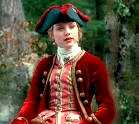










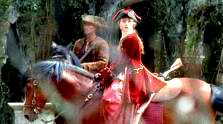
















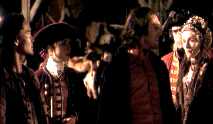
Ice skating costume
(cut from the movie)
This seems to be a giant (fox?) fur coat. This costume was in a scene that was cut from the movie, but it’s still shown in the DVD specials. It sometimes seems as if it was worn over a blue skirt, but that can’t be safely said. Some scenes show Marianne wearing a matching fur cap with the coat and some don’t.
‚Snow‘ dress
Blue-red combination
Church dress
Marianne’s only dress that we never see completely. Seems to be a Francaise in some blue / cream patterned satiny fabric, but those are the only things that can be safely said.
Blue taffeta gown
Probably the gown with the most screen time!
Blue-black shot taffeta Francaise. The sleeve flounces are designed with fraying edges, which looks interesting.
Dark green (black) riding habit
The costume seems black in the scenes in which it is worn; but in two shots in Marianne’s room it’s lying over a chair (last two pictures) and there, it’s dark green.
the costume seems very much likely to the red riding habit, but on close inspection, it’s not. The collar / front lapels and cuffs are totally different, and the back is split.
It’s most interesting that ‚Fashion‘ – the book on the collection of the Kyoto Institute of Costumes, which shouldn’t be missing in any costumer’s library – shows a male leather hunting jacket which has exactly the same front lapels.
Peach nightdress
Light blue dress
This dress is never shown from the front. It’s the last dress Marianne is wearing in the movie. The skirt seems to be made of blue material and has some kind of half transparent white overlay (white batiste? Netting?). The bodice seems to be pale aqua blue.
Sylvia
(Monica Bellucci)
Yellow-black lace (un)dress
The lavish usage of lace is not so historical for that period; nevertheless, we have a beautiful (un)dress here 😉
Red-black (un)dress
The bodice is decorated with endless amounts of red pearls and black cut beads. She’s wearing a black, transparent panier and some kind of red train with this outfit.
Blue velvet dress
This is worn when Sylvia comes to dig Grégoire from his grave. It’s – in my opinion – one of the most beautiful costumes in this movie.
Hopefully I don’t need to mention that the black sequins on her veil are not historic – neither in shape nor in color.
The ‚killing outfit‘
Not much to say about this – it has too few screen time and not even the specials give out more about it.
Black (un)dress
This is actually a transparent Francaise!
Sylvia’s church dress
Seems to be one of the most decorated and beautiful costumes in the movie – but it’s never shown completely from the front.
It’s either dark blue or black; I think it’s dark blue. The stomacher is decorated with embroideries. The sleeves are decorated in the same way as Marianne’s dinner dress – just with black lace!
‚Prison‘ outfit
This is worn by Sylvia when she visits Gregoire in prison to poison him. The cloak has some beautiful silver embroideries and is completely lined with orange/golden shot taffeta. The gown shown below is dark green and decorated with silver buttons.
‚Battle‘ outfit
The collest thing is probably her fan, which has sharp points to slit any enemie’s throat (which it actually does in the movie – that’s why the silver points are stained red in some of the following screenshots).
Below the black (velvet?) cloak with paisley-like embroideries along the edges Sylvia is wearing a black, silver-decorated dress.
The leather coats of Grégoire de Fronzac (Samuel Le Bihan) and Mani (Mark Dacascos)
Tidbit which has nothing to do with costumes: Did you know that Mark Dacascos grew up in Hamburg…? Born in Hawaii, he moved here to Germany at young age so that his parents could found martial art schools here, which still exist. This explains why he became European champion in Kung Fu when he was eighteen 😉





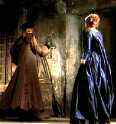








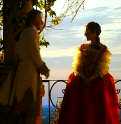




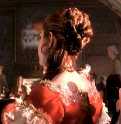








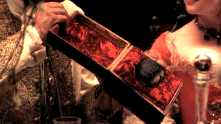



















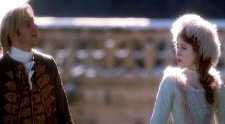



















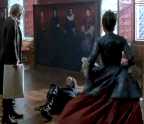






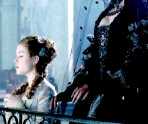
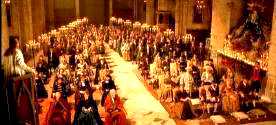

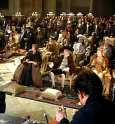








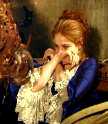
















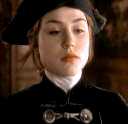




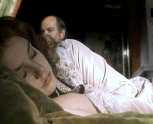














































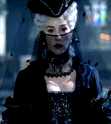













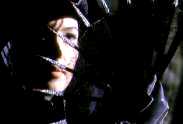
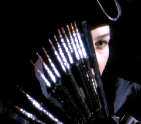









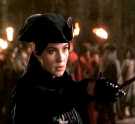
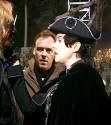
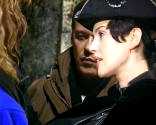














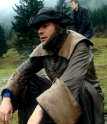
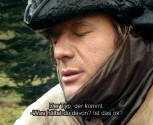





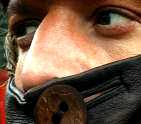






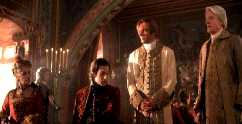
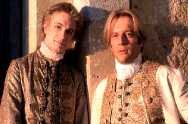






















How would you describe one of those coats with the big collar that covers their faces? Is there a period specific name for it?